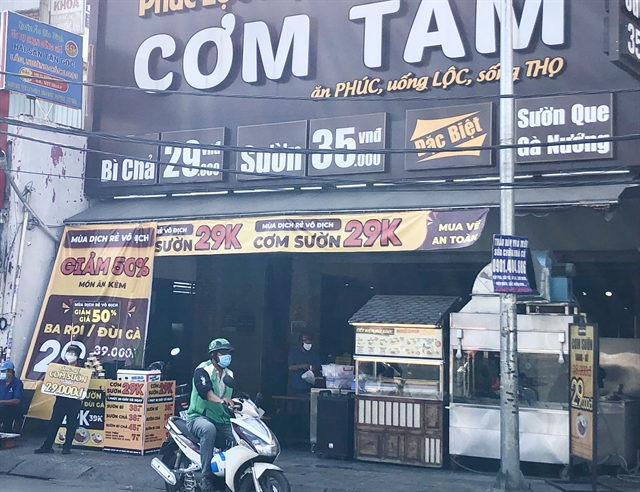[ad_1]

HCM CITY — Like many street food and beverage stalls now in HCM City, the eatery owned by Nguyễn Hồng Vân on Võ Oanh Street near the HCM City University of Transport in Bình Thạnh District only offers takeaway.
She says, “I used to sell at least 400 meals during lunch time besides a large quantity of soft drinks and fruit juices, with my customers mainly being students and teachers.
“But sales have fallen dramatically since the city ordered schools to switch online and roadside restaurants to not serve customers on the spot to prevent COVID-19.
“I find many street food stalls have closed temporarily. I can’t do so because then it will be hard for me to find such good staff as I have now when things return to normal. So I have managed to find new customers by promoting sales on social networks and send daily menus to office buildings, construction sites and other places.
“I am negotiating with Now and Grabfood to sell my food on these platforms.”
Businesses with experience selling online have been less affected.
Vỹ, owner of a food stall on Xô Viết Nghệ Tĩnh Street in Bình Thạnh District, says: “We have been selling our products on Now and Loship for nearly two years, and are getting an increasing number of orders from these apps. So our total sales reduced but not by much compared to other street food stalls who do not sell online.”
At Phúc Lộc Thọ broken rice restaurant on the same street, many Grab, Now and Baemin drivers wait to pick up food for delivery.
Linh, a seller at the restaurant, said the restaurant has been receiving an increasing number of orders from these platforms, and has also cut prices sharply to share the burden with customers.
Coffee chains such as The Coffee House, Trung Nguyên, and Cheese Coffee or fast food chains Lotteria and KFC have their own online ordering apps and also use food delivery partners like Grab, Now, or Baemin.
With the COVID-19 pandemic continuing since 2020, online sales have become inevitable in many sectors, including food and beverages, according to industry insiders.
Nevertheless, onsite dining remains the main source of income for many restaurants, and takeaway accounts for a small portion of their revenues.
Many restaurants have closed temporarily to save costs, but some remain open and sell online to keep their brand’s flag flying.
There are two main online sales trends in the food and beverage sector: tying up with ordering platforms such as Now, Grab and Loship to sell or develop their own sales channel.
If restaurants choose to tie up with third parties for delivery they will not have much pressure in terms of selling and shipping, but have to pay high commissions and will not know their customers to offer post-sales service.
Besides, too many eateries compete to sell on these apps, and buyers sometimes find it hard to get driver to receive their orders.
But developing their own online sales channel means they need to have employees to manage it.
iPOS.vn, a technology company focused on the F&B industry, is providing solutions that support both third party and direct online sales.
Its FABi management software directly connects with GrabFood and Loship, and restaurant owners can register to sell on these platforms easily, with many exclusive supports and preferential treatments.
If restaurants want to build their own channels, it helps them open stores on Zalo and Facebook, and integrates with AhaMove to help deliver when there is an order.
Vũ Thanh Hùng, CEO of iPOS.vn, said: “It is important for the F&B sector to embrace online sales to maintain their operations because demand for food is still great. Selling through ordering platforms is good if brands can manage the costs and still make a profit.
“However, as these apps are increasingly overloaded with brands, eateries should develop a separate sales channel and gradually attract customers to them. In my opinion, a reasonable rate in the number of online orders today is 80 per cent through third party platforms and 20 per cent on the restaurants’ own sales channels.”
He also said restaurants should consider joining cloud kitchens, or centralised food production facilities set up for multiple restaurants specifically for delivery.
This model enables restaurant to lower costs, while marketing is undertaken by the cloud kitchen owners, so this is a good choice in the context of the current epidemic, he added. — VNS

Chú thích ảnh
[ad_2]
Source link
